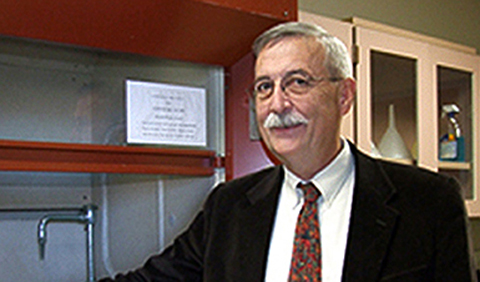Dr. Gar W. Rothwell, distinguished professor emeritus of Environmental & Plant Biology, recently co-authored two publications, identifying fossilized plant species from the Upper Cretaceous and Late Cretaceous periods.
In Evolutionary diversification of taiwanioid conifers: evidence from a new Upper Cretaceous seed cone from Hokkaido, Japan, Rothwell and his co-authors report that “a single cylindrical seed cone 2 cm long, 1.1 cm wide has been found preserved in a calcium carbonate marine concretion from the Hakobuchi Formation (late Campanian-early Maastrichtian) of Hobetsu, Hokkaido, Japan.
“This cone is described as Mukawastrobus satoi Stockey, Nishida and Rothwell. Together with previously described Early to Late Cretaceous taiwanioid seed cones from Mongolia and Hokkaido the new species demonstrates that the taxonomically diagnostic characters of such conifers are as subtle as those of Cretaceous and Cenozoic sequoioid Cupressaceae. This realization emphasizes that evolutionary diversification and turnover among taiwanioid conifers during the Cretaceous and Paleogene are probably far greater than currently recognized,” write Rothwell and co-authors from Oregon State University and Chuo University in the Journal of Plant Research article.
Another article, Evolution and phylogeny of Altingiaceae: anatomically preserved infructescences from Late Cretaceous deposits of Vancouver Island, British Columbia, Canada, was published in the International Journal of Plant Sciences.
In this article, Rothwell and co-authors from Oregon State note write, “Five permineralized specimens of infructescences and dispersed fruits assignable to the Altingiaceae have been identified from the Late Cretaceous (Coniacian) Eden Main Quarry on Vancouver Island, British Columbia, Canada. Two infructescences and three isolated two-loculed fruits are preserved in calcium carbonate marine concretions.”
They conclude: “These fossils represent the second-most ancient occurrence of Altingiaceae, and phylogenetic analysis of morphological characters confirms that P. comoxense is most similar to species of Altingia. Results of morphological analyses resolve Altingia and Liquidambar as sister clades, placing P. comoxense as the basal member of the Altingia clade and sister to Altingia spp., thus documenting that evolutionary diversification of the core eudicot family Altingiaceae (Saxifragales) was well underway by the mid–Upper Cretaceous.”




















Comments